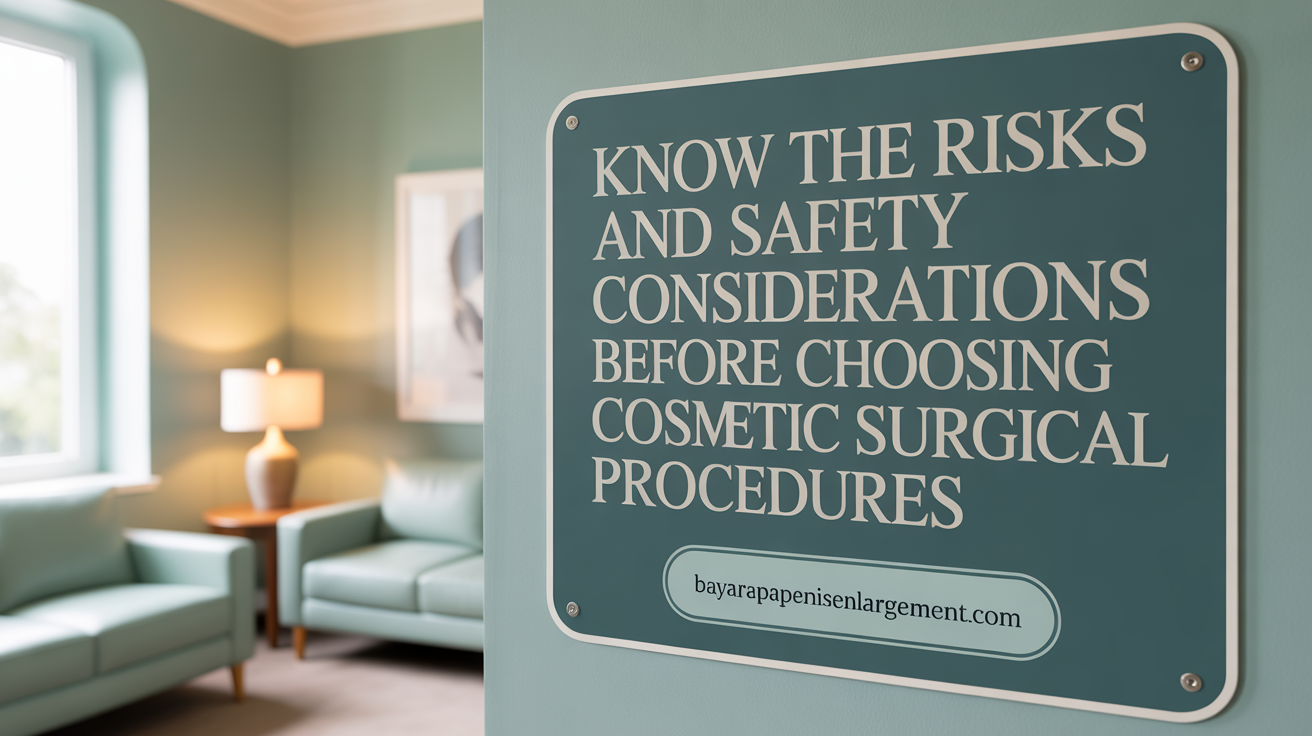Understanding the Landscape of Penis Enlargement Surgery in the U.S.
Penis enlargement surgery continues to gain attention across the United States as more men seek solutions to concerns about penile size and appearance. This article delves into who is pursuing these procedures, the surgical and non-surgical methods available, motivations behind this growing trend, and the critical medical, psychological, and financial factors influencing men’s decisions. We explore expert opinions, safety considerations, and recovery expectations, providing readers with a comprehensive overview of a complex and sensitive topic in contemporary male health and cosmetic surgery.
Common Surgical Procedures for Penis Enlargement in the U.S.
What are the common surgical procedures available for penis enlargement in the U.S.?
In the United States, men seeking penile enhancement can choose from several surgical options depending on their goals and health status. One of the most well-known procedures is ligamentolysis, which involves cutting the suspensory ligament to make the penis appear longer by releasing its support from the pubic bone. This technique can increase visible length but does not alter the actual size of the erect penis.
Another popular approach is girth enhancement using autologous fat injections. In this minimally invasive procedure, fat is transferred from other parts of the body into the penile shaft to add volume. Dermal fillers, such as hyaluronic acid, are also used for non-permanent girth increases, providing immediate results without surgery.
The only FDA-cleared device specifically approved for penis enlargement is the Penuma® silicone implant. This surgical implant can increase both girth and, to some extent, length. The Penuma® procedure typically takes about 45 minutes and is performed under local or general anesthesia. It is designed for men who are satisfied with their erect function but wish to improve aesthetic appearance.
While some surgeons may perform silicone implants or extensive fat transfer procedures, the American Urological Association notes that fat injections and suspensory ligament division may not always be safe or effective. Risks such as infection, scarring, or dissatisfaction with results can occur, so thorough consultation and realistic expectations are essential.
Choosing the right procedure depends on individual goals and health considerations. Consulting a qualified urologist ensures personalized treatment planning, safety, and optimal results.
Non-Surgical and Minimally Invasive Treatments

Are there any scientifically supported methods or treatments to enlarge the penis size other than surgery?
Yes, there are several non-surgical options backed by scientific research that can lead to modest increases in penis size, primarily in girth or length. These methods include penile traction devices, injectable fillers, and certain implant devices.
Penile traction devices, such as extenders and stretchers, utilize sustained gentle pulling to gradually lengthen the penis. Clinical studies indicate these devices can potentially add less than 2 centimeters to the erect length with consistent use over several months. While their safety profile is generally good, results vary among individuals, and psychological benefits should also be considered.
Injectable fillers have gained popularity for girth enhancement. Materials like hyaluronic acid, poly L-lactic acid, and polymethyl methacrylate (PMMA) microspheres are injected into the penile shaft to increase circumference. Research shows these fillers can produce gains of about 2 to 3.5 centimeters in girth, with high patient satisfaction and minimal serious side effects. These procedures are usually minimally invasive, performed under local anesthesia, and effects last between 12 to 24 months, often requiring repeat treatments.
Another approach is the use of silicone implants like the FDA-approved Penuma® device. This silicone device, implanted under the skin, has demonstrated significant girth expansion—averaging around 56.7% increase—with high levels of satisfaction among patients. While primarily considered cosmetic, some patients experience functional benefits as well.
Less proven methods include vacuum devices, which create suction to temporarily enlarge the penis, and tissue engineering using biodegradable scaffolds. However, these techniques generally lack conclusive evidence for causing permanent size increases.
In summary, while non-surgical treatments cannot match the dramatic results of surgical procedures, they offer safe, effective options for those seeking modest size enhancements. It's essential, however, to consult with a qualified urologist or specialist to discuss realistic expectations, potential risks, and the most suitable approach for individual goals.
Who Seeks Penis Enlargement Surgery in the U.S.? Demographics and Motivations

What are the primary motivations and psychological or social factors influencing men in the U.S. to seek penis enlargement surgery?
Men in the United States typically pursue penis enlargement surgery for a variety of reasons, most of which are rooted in concerns about appearance and body image.
A significant motivator is the desire to meet societal standards of masculinity and attractiveness. Media exposure, including pornography, often depicts men with larger penises, which can influence perceptions and expectations. These portrayals can make men feel insecure about their own size, leading to dissatisfaction with their bodies.
Psychological factors also contribute. Some men experience body dysmorphic disorder (BDD), where they perceive their penis as smaller or imperfect, regardless of actual size. Low self-esteem and feelings of inadequacy can motivate efforts to improve confidence through surgical procedures.
Social influences, such as peer comparison and cultural notions of masculinity, reinforce these concerns. Men may fear judgment or rejection in their intimate relationships, prompting them to seek surgical enhancement.
While the majority seek surgery for aesthetic reasons, some individuals believe that increasing penis size may improve sexual performance or satisfaction, although medical studies show mixed results regarding functional benefits.
In summary, the decision to undergo penis enlargement surgery in the U.S. is often driven by a combination of societal influences, personal body image issues, and psychological factors that shape men's perceptions of their masculinity and attractiveness.
| Demographic Profile | Common Motivations | Underlying Influences |
|---|---|---|
| Typically men aged 20-50 | Improving appearance | Societal and media standards |
| Often those with body dissatisfaction | Increasing self-confidence | Peer comparison |
| Men with concerns about sexual image | Enhancing sexual confidence | Cultural ideals of masculinity |
| Men experiencing anxiety about size | Addressing body dysmorphic concerns | Influence of pornography |
Understanding these motivations helps practitioners provide better counseling, setting realistic expectations and addressing underlying psychological needs.
Candidacy Criteria and Medical Evaluation for Penis Enlargement Surgery
What factors determine candidacy for penis enlargement surgery in the U.S.?
Deciding whether you are a suitable candidate for penis enlargement surgery involves several important factors. Primarily, your overall health and medical history are reviewed to reduce surgical risks. Candidates should be in good physical condition, without major health issues such as blood clotting disorders, infections, or other underlying conditions that might complicate surgery.
Besides physical health, psychological readiness plays a crucial role. Patients should have a clear understanding of what the surgery can realistically achieve and maintain healthy expectations about outcomes. This helps prevent dissatisfaction and psychological distress post-procedure.
Men who are dissatisfied with the aesthetic appearance of their penis, especially in the flaccid state, and those experiencing functional issues like difficulty with penetration or self-confidence problems may consider surgery.
Before proceeding, a comprehensive consultation with a qualified urologist or plastic surgeon is necessary. This evaluation includes examination, discussing goals, and identifying any contraindications such as active infections or certain blood clotting issues.
Overall, candidacy depends on a combination of physical health, mental readiness, and a thorough medical screening process designed to maximize safety and effectiveness.
| Eligibility Factors | Details | Additional Information |
|---|---|---|
| Physical health | No major illnesses, stable condition | No uncontrolled cardiovascular issues |
| Mental readiness | Clear understanding of outcomes | Managing realistic expectations |
| Absence of contraindications | No active infections or bleeding disorders | Preoperative tests to confirm health |
| Specific cases | Micropenis diagnosis | Defined as penis <7.5 cm when stretched |
| Age considerations | Usually adult men | Minors require special legal and medical clearances |
Expected Outcomes and Effectiveness of Procedures

What is the expected effectiveness and typical outcomes of penis enlargement surgeries performed in the U.S.?
In the U.S., penis enlargement procedures aim to enhance both length and girth. Various techniques are utilized, including ligamentolysis (suspensory ligament division), fat injections, dermal fillers, and implant placements such as the FDA-approved Penuma® device.
Patients generally experience tangible size increases—length can increase by approximately 1 to 5 centimeters (about 0.4 to 2 inches), while girth may expand by 1 to 3 centimeters (about 0.4 to 1.2 inches). Aside from physical changes, many report a boost in self-confidence and sexual satisfaction.
However, outcomes depend heavily on the chosen procedure, individual health, and realistic expectations. Patients should be aware that results can vary, and some may be dissatisfied due to unanticipated complications or limited size gains.
Risks such as infection, scarring, changes in shape, loss of sensation, and erectile dysfunction are associated with these surgeries. The complication rate depends on the technique used and the surgeon’s expertise.
Recovery varies but typically involves several weeks of abstaining from sexual activity and strenuous exercise. While most adverse outcomes are minor and manageable, long-term data on durability and satisfaction are limited.
In summary, while penis enlargement surgeries can provide noticeable size enhancements and psychological benefits, they are not guaranteed solutions and should be approached with comprehensive consultation and realistic goals.
Risks, Safety Considerations, and Potential Complications

What are the typical risks, safety considerations, and potential complications associated with penis enlargement surgery in the U.S.?
Penis enlargement surgery in the United States involves various procedures designed to enhance length or girth. However, these come with notable risks and safety concerns. Common complications include infection, scarring, edema, and the potential for penile deformity or severe shortening. In procedures involving implants or injections of foreign substances like silicone or fat, the risk of adverse outcomes such as tissue hardness, irregular shape, or loss of sensation increases.
The American Urological Association (AUA) explicitly states that fat injections and suspensory ligament division are generally considered neither safe nor effective. These procedures can lead to unpredictable results and higher complication rates. Risks associated with anesthesia and postoperative recovery include pain, bleeding, and scarring, which may extend recovery time and impact satisfaction.
Most health insurance policies do not cover cosmetic procedures, emphasizing the importance of thorough preoperative counseling. Patients must understand the serious potential complications, including infection, implant malfunction, and dissatisfaction. It is vital to select experienced, qualified healthcare providers to minimize risks and ensure appropriate management of complications.
While some innovations like FDA-approved silicone implants (e.g., Penuma®) show promising results, they still carry risks such as seroma or capsular contracture, with a reported complication rate of around 4%. Overall, candidacy should be carefully evaluated, and realistic expectations must be maintained to navigate the risks involved.
Recovery Process and Timeframe After Surgery
What does the recovery process after penis enlargement surgery entail, and what is the expected timeframe in the U.S.?
The recovery period following penis enlargement surgery requires careful attention to postoperative care. Patients typically experience swelling, redness, and some discomfort, which gradually improve over time. To support healing, most surgeons recommend wearing loose-fitting clothing to avoid pressure on the surgical site and avoiding strenuous activities such as heavy lifting or vigorous exercise for at least 30 to 60 days.
During the initial weeks, pain management and hygiene are crucial. Patients are usually advised to refrain from sexual activity, masturbation, and other intense physical activities to prevent complications and ensure proper healing.
Follow-up visits are vital to monitor progress, remove stitches if necessary, and detect any early signs of infection or other issues. Compliance with medical advice and maintaining a healthy lifestyle can significantly influence the outcome.
Most individuals notice that swelling and discomfort lessen within the first few weeks. However, complete healing and the final appearance of the results can take several months, often up to six months or more, depending on the specific procedure and individual healing response.
Financial Considerations: Costs and Insurance Coverage
What is the general cost range and financial considerations for penis enlargement surgery in the U.S.?
Penis enlargement procedures in the United States can vary widely in cost, often making it a significant financial investment for those seeking enhancement. The most common surgical option, the Penuma® silicone implant, is typically priced around $15,000 out-of-pocket. This amount reflects the full cost of the procedure, as insurance companies generally do not cover cosmetic enhancements unless they address a functional disorder.
Patients usually need to make an initial deposit of about $1,000 when scheduling their surgery. The total cost covers the implantation process, which involves inserting a specially designed silicone device under the skin to increase both length and girth. The surgery itself is relatively quick, often completed within 45 minutes to an hour, and is performed under general anesthesia.
Since these procedures are considered elective cosmetic surgeries, most patients should expect to cover the full cost themselves. It is advisable for individuals to plan financially ahead of time and explore options for payment plans or financing when available. Understanding the expenses involved and setting realistic expectations about affordability can help in making informed decisions about undergoing surgery.
Additional financial considerations include:
- Postoperative expenses such as medications, follow-up visits, and possible revisions.
- The typical recovery period of about six weeks, during which strenuous activities and sexual activity are restricted.
- Possible costs for non-surgical or minimally invasive alternatives, which tend to be less expensive but offer temporary results.
In summary, patients should approach penile enhancement with thorough financial planning, considering both the upfront and ongoing costs associated with the procedure.
Comparison of Surgical Techniques and Innovations

How do different surgical techniques for penis enlargement used in the U.S. compare regarding methods and results?
In the United States, a variety of surgical procedures are performed to enhance penis size, particularly during penile prosthesis (PP) implantation. These methods include traditional approaches like cavernosal sparing, subcoronal incisions with degloving and grafting, and more advanced techniques such as the sliding method, modified sliding (MoST), multiple-slit (MuST), and the tunica expansion procedure (TEP). Each technique has its unique approach to increasing length or girth.
Cavernosal sparing, for example, preserves surrounding tissues to possibly increase length, while grafting involves adding tissue to expand girth. The sliding technique involves carefully dissecting tissues to extend the penile shaft, often resulting in an average length gain of about 1 to 3 centimeters.
The recent innovation, the tunica expansion procedure (TEP), stands out by making small, staggered incisions along the tunica albuginea to maintain or enhance both length and girth. This method typically uses a less invasive approach through a scrotal incision, which is more cosmetically appealing and involves less risk.
Preoperative penile traction therapy, especially with devices like RestoreX, has been shown to augment potential gains by approximately 1.5 to 1.9 centimeters before surgery. This therapy can support postoperative results when combined with other surgical strategies.
Postoperative care often involves device inflation and careful cylinder sizing to prevent loss of gains and further improve length. Successful outcomes depend on careful patient selection, proper surgical execution by experienced specialists, and managing expectations.
Below is a comparative summary of the different methods, their typical outcomes, and associated considerations:
| Technique | Method | Average Length Gain | Girth Enhancement | Notable Risks | Additional Notes |
|---|---|---|---|---|---|
| Cavernosal Sparing | Tissue preservation | 0.8 - 1.2 cm | Moderate | Less invasive but limited impact | Suitable for some candidates |
| Grafting & Girth | Tissue grafts | Variable, up to 2 cm | Significant | Infection risk, scarring | Used to increase girth |
| Sliding & Modified Sliding | Dissection & tissue release | 1 - 3 cm | Variable | Scarring, nerve damage | Advanced technique |
| Tunica Expansion Procedure (TEP) | Small incisions along tunica | Often > 1.5 cm | Maintains or slightly enhances girth | Minimal, scarring at incision sites | Innovative, less invasive |
Overall, newer techniques like TEP show promising results with fewer risks and better cosmetic outcomes. Combining preoperative traction therapy with surgical procedures can further optimize results. The choice of technique depends on individual goals, health status, and surgeon expertise, highlighting the importance of consultation with a specialized urologist or surgeon experienced in penile enhancement.
Expert Medical Insights and Ethical Considerations
What expert medical opinions and professional evaluations are available regarding penis enlargement procedures in the U.S.?
In the United States, medical experts generally recommend caution when considering penis enlargement procedures. The only FDA-approved method specifically for cosmetic enlargement is the Penuma silicone implant, which has demonstrated high patient satisfaction and an average increase in girth of approximately 56.7%. Its approval under the 510(k) regulation indicates it has passed safety and efficacy evaluations for market release.
Other popular methods, such as fat transfer, suspensory ligament division, and dermal fillers, lack FDA approval and are often regarded by major urological associations as unsafe or ineffective. The American Urological Association explicitly considers fat injections and suspensory ligament division to be neither safe nor reliable for enlargement purposes.
Medical professionals emphasize that surgery should primarily be limited to cases of micropenis, where the erect length measures 7.5 centimeters or less. For most individuals seeking cosmetic enhancement, risks include deformity, infection, erectile dysfunction, and dissatisfaction with results. Since many of these procedures are not covered by insurance and do not stand up to rigorous medical evaluation, experts recommend thorough consultation with qualified urologists to understand realistic outcomes and potential complications.
In summary, the prevailing expert opinion discourages non-approved methods due to safety concerns and advises that patients carefully assess the necessity and legitimacy of any surgical claims with trusted healthcare providers.
Weighing the Pros and Cons of Penis Enlargement Surgery
Penis enlargement surgery in the U.S. occupies a nuanced space bridging medical innovation, psychological desire, and cultural influence. While a variety of surgical and non-surgical methods exist, the only FDA-cleared option for cosmetic enlargement is the Penuma implant, underscoring a regulatory emphasis on patient safety and efficacy. Men seeking these procedures often grapple with psychological factors shaped by body image and social pressures, making candidacy assessment and realistic expectations critical. The significant risks and costs involved necessitate informed, thorough consultation with qualified specialists. Recovery requires patience and adherence to medical guidance to minimize complications. As the field advances with novel surgical techniques and non-invasive treatments, ongoing research and ethical discussions will shape future standards. Ultimately, the decision to pursue penis enlargement surgery is deeply personal and should be made with careful consideration of all medical, psychological, and social dimensions involved.
References
- Penis Enlargement Surgery: How It Works, Pros & Cons
- Penis enlargement surgery: Does it work, and is it worth it?
- Offering Patients Innovative Options for Penile Enhancement
- Non-Surgical Penile Girth Enhancement Specialist in NYC
- Penis Enlargement in Raleigh
- Penile implants - Mayo Clinic
- Penile Enhancement in New York, NY - Millennial Plastic Surgery
- Penis Enlargement - Urologist Tijuana
- Penis Enlargement Surgery (Phalloplasty) Recovery & Aftercare

